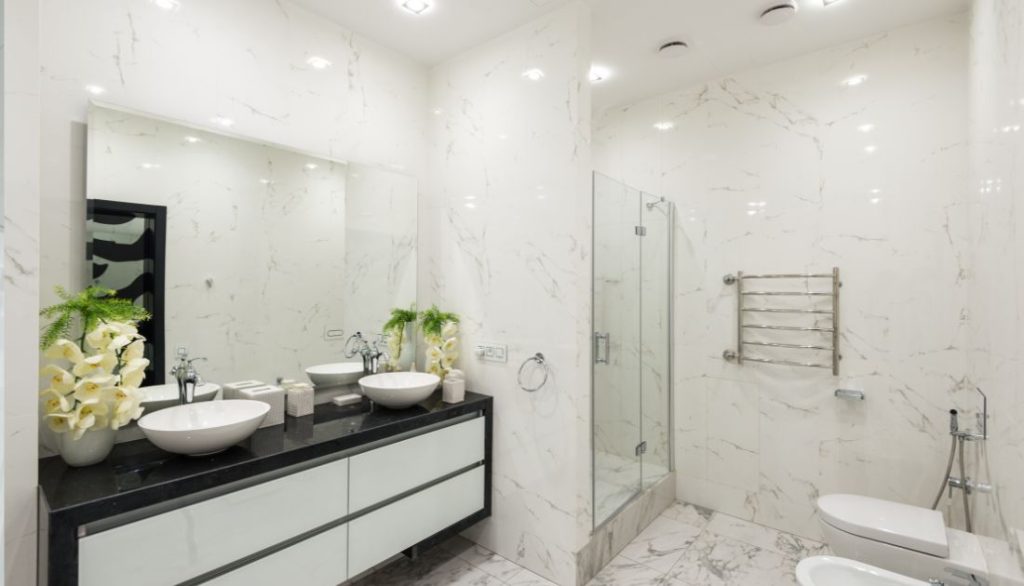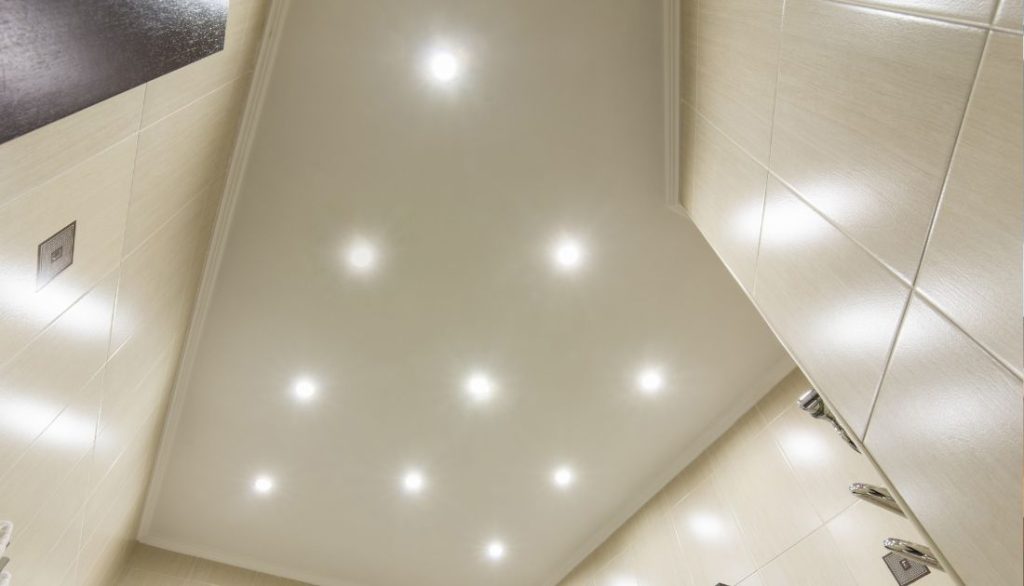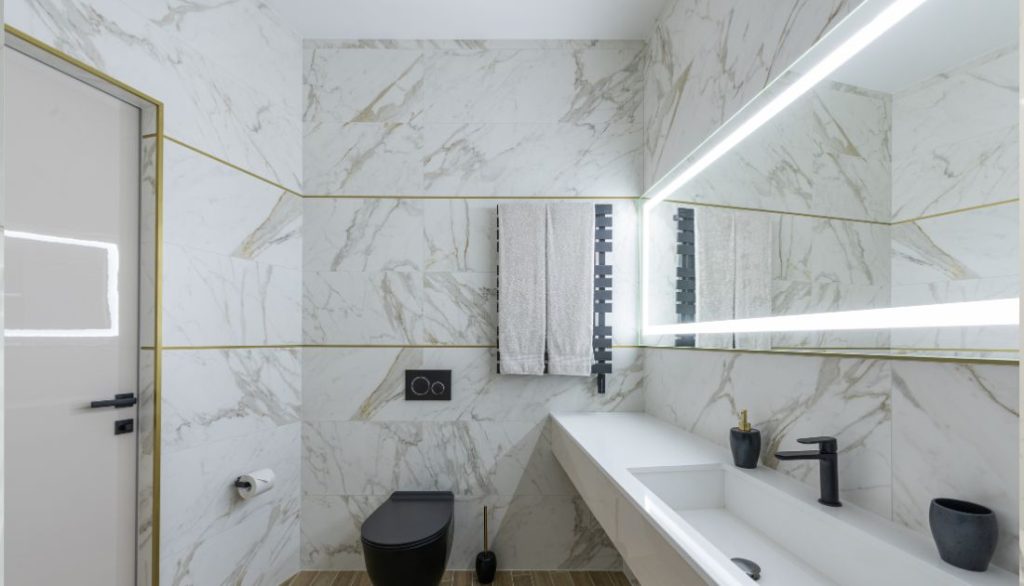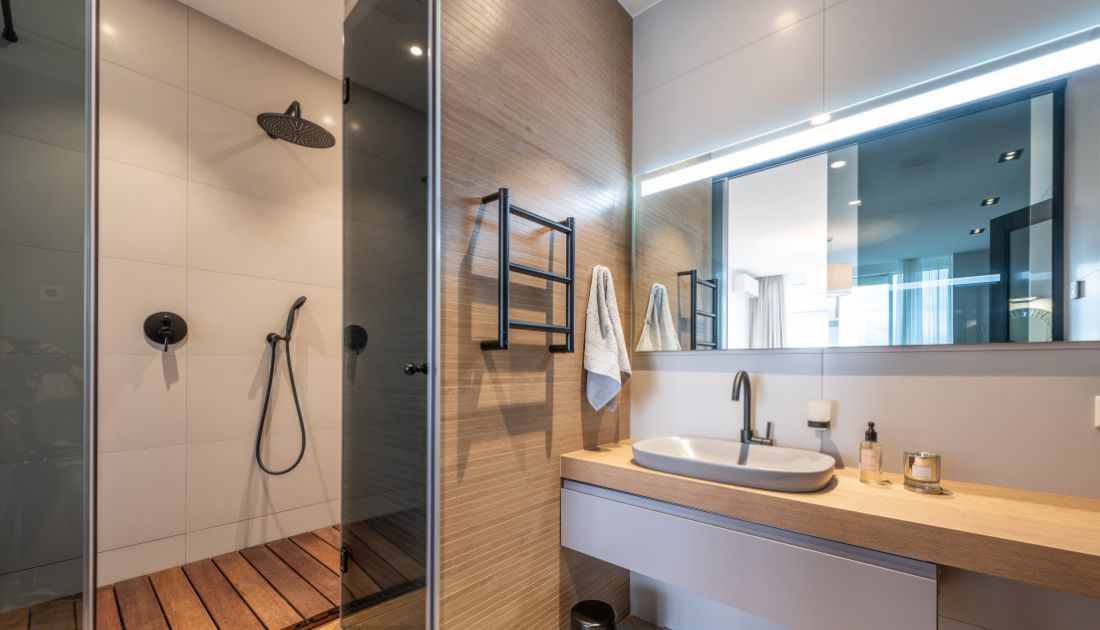Table of Contents
Creating the perfect bathroom goes beyond just picking nice tiles and fixtures. Lighting is key to making your bathroom both beautiful and practical. From general lighting that lights up the whole room to task lighting for things like shaving or applying makeup and accent lights that add a touch of style, each type of light has an important role. Whether you want a calm, spa-like feel or a bright, useful space, understanding bathroom lighting is essential.
Understanding the Importance of Bathroom Lighting
Good bathroom lighting is essential for creating a functional and stylish space. Proper lighting can enhance the room’s overall aesthetic while providing illumination for daily grooming tasks.
- Bright, well-placed lights can make small bathrooms appear larger and more inviting.
- Adequate lighting around mirrors is crucial for tasks like shaving or applying makeup.
- Consider incorporating dimmable options to create a relaxing ambiance during baths or showers.
When designing your bathroom lighting scheme, consider both aesthetics and functionality. By carefully choosing fixtures and positioning them strategically, you can achieve a well-lit and visually appealing space that meets all your needs.
Types of Lighting Fixtures for Your Bathroom
Vanity Lights
Vanity lights are essential for providing even lighting on your face while you’re grooming or applying makeup. These fixtures are typically installed above or on the sides of your bathroom mirror to reduce shadows and ensure proper illumination. Look for vanity lights with adjustable settings to customize the brightness level based on your needs.
Ceiling Lights
Ceiling lights, such as flush-mount or semi-flush-mount fixtures, are great options for overall ambient lighting in your bathroom. These fixtures provide general illumination throughout the space and can be complemented with additional task lighting near mirrors or areas with more light.
Wall Sconces
Wall sconces add a decorative touch to your bathroom while offering focused light in specific areas. Install them on either side of a mirror or artwork to create a balanced, aesthetically pleasing look. Consider dimmable wall sconces for added versatility in controlling the ambiance of your bathroom space.

Bathroom Lightning Innovative Ideas
1. General Lighting
General lighting, also known as ambient lighting, is the foundational layer of light in a bathroom. It provides uniform illumination, ensuring the space is well-lit and safe to navigate.
Typically, this is achieved through ceiling-mounted fixtures like recessed or flush-mount ceiling lights. The goal is to create a soft, inviting glow that eliminates shadows and evenly lights the room. A single ceiling fixture in smaller bathrooms might suffice, whereas larger spaces may require a combination of lights to avoid dark corners.
2. Task Lighting
Task lighting is crucial for activities that require more focused light, such as shaving, applying makeup, or brushing teeth. The most common task lighting application in bathrooms is around the vanity area.
Ideal fixtures include vertical sconces mounted on either side of the mirror or a strip light above the mirror. These should be positioned at eye level to minimize shadows and provide clear, bright light that mimics natural daylight. LED lights are often recommended for their brightness and energy efficiency.
3. Spa Magic
Creating a spa-like atmosphere in the bathroom can transform the space into a relaxing retreat. This involves layering soft, indirect lighting to create a calming ambiance. Features like dimmable lights, wall sconces with frosted glass, or even LED strip lights under floating vanities can contribute to this effect.
Incorporating warm color temperatures (2700K-3000K) can enhance the soothing feel. Additionally, incorporating elements like backlit mirrors or under-cabinet lighting can add to the serene environment.
4. Additional Impact
Accent lighting can make a statement in a bathroom by highlighting architectural features, artwork, or special design elements. This can be achieved through spotlights, LED strips, or small recessed lights.
Illuminating a unique tile pattern, a stylish bathtub, or a piece of art can add a dramatic touch. These lights should be adjustable to focus on specific points of interest without overpowering the general or task lighting.
5. Nightlight
Nightlights in the bathroom provide safety and convenience without disturbing sleep. Options include dimmable lights, motion sensor lights, or low-level LED strips. These can be installed under cabinets, along the baseboards, or into vanity lights. The light should be soft and low-level, just enough to navigate the space safely without being too bright or harsh.
6. Finishes
The finish of bathroom lighting fixtures plays a significant role in the overall design and feel of the space. Popular finishes include chrome, brushed nickel, brass, and matte black.
Chrome and brushed nickel are versatile and blend well with most bathroom decors, while brass and matte black can make bold, stylish statements. The choice of finish should complement other fixtures and fittings in the bathroom, such as faucets, towel bars, and cabinet hardware, to create a cohesive look.
7. Lighting Controls
Effective lighting controls enhance the functionality and versatility of bathroom lighting. Installing dimmer switches allows for adjustable light levels, perfect for transitioning from bright task lighting to soft ambient lighting.
Advanced options include smart lighting systems that can be controlled via smartphone or voice commands, offering convenience and customization. Motion sensors are also practical for automatic night lighting, ensuring safety and energy efficiency by turning lights on and off as needed.

Choosing the Right Bulbs for Maximum Impact
Select LED or CFL bulbs for energy efficiency and long-lasting performance. Consider the color temperature of the bulbs to create the desired atmosphere in your bathroom. Opt for dimmable bulbs to adjust the lighting levels based on your needs.
When choosing bulbs, keep in mind that brighter is not always better. Soft, warm light creates a cozy and inviting ambiance, while cooler tones are ideal for tasks like makeup or shaving.
Experiment with different bulb types and wattages to find what works best for your space. Ultimately, selecting the right bulbs will enhance the overall aesthetic of your bathroom while providing functionality and style.
Layering Light for a Multi-functional Space
Consider using a mix of task, ambient, and accent lighting to create a well-lit bathroom that serves multiple purposes. Task lighting, such as vanity lights or sconces around the mirror, will provide ample illumination for grooming activities. Ambient lighting can be achieved through overhead fixtures like chandeliers or recessed lights to brighten the entire space.
Accent lighting with wall-mounted fixtures or LED strip lights can add a touch of elegance and highlight specific areas in the bathroom. By strategically layering these different types of light sources, you can achieve functionality and aesthetics in your bathroom design.
Remember to incorporate dimmers for adjustable brightness levels to cater to daily needs.
Creating a Spa-like Ambiance with Lighting
Dimmer Switches: Install dimmer switches for adjustable lighting levels to create a relaxing atmosphere in your bathroom.
LED Light Strips: Add LED light strips around mirrors or under cabinets for a modern, sleek look.
Sconces or Pendants: Incorporate wall sconces or pendant lights to provide task lighting while adding style to the space.
Enhance your bathroom oasis by strategically placing different light sources throughout the room. Consider using soft, warm lighting near the bathtub for a calming experience. Opt for bright, white lighting around the vanity area for optimal visibility during grooming tasks. Experiment with diffused light fixtures like frosted glass pendants to soften harsh shadows and create a tranquil environment.
Tips for Maximizing Natural Light
Keep windows clear: Clean your windows regularly to let possible natural light into the bathroom.
Use sheer curtains: If privacy is a concern, choose sheer curtains that allow ample natural light while still providing a degree of privacy.
Position mirrors strategically: Placing mirrors opposite windows can help reflect and amplify natural light throughout the space.
Maximizing natural light in your bathroom brightens the room and creates a more inviting and refreshing atmosphere.
These simple tips allow you to maximize sunlight and enhance your lighting design.
Accent Lighting for a Stylish Touch
Accent lighting enhances the ambiance of your bathroom, adding a touch of style to your space. For an elegant effect, consider installing wall sconces on either side of the mirror. Opt for dimmable fixtures to create a soft, inviting glow perfect for unwinding after a long day.
Tips for accent lighting:
Use LED strip lights under cabinets or along shelves to highlight decorative items.
Place small spotlights above artwork or architectural features to draw attention.
Install recessed lights in alcoves or niches to create visual interest and depth.

Incorporating Smart Technology for Ultimate Convenience
Upgrade your bathroom lighting design with the latest innovative technology to enhance your daily routine.
Install intelligent LED bulbs that can be controlled remotely through a mobile app or voice commands.
Set the mood with customizable color options and brightness levels to create the perfect ambiance for any time of day.
Invest in a smart mirror with built-in lighting features for convenience during grooming. These mirrors often come equipped with touch sensors, defogging capabilities, and Bluetooth speakers.
Consider installing motion sensor lights in critical areas of your bathroom for hands-free operation.
FAQs:
What are the different kinds of lights?
There are several types of lights used in bathroom design:
- Ambient Lighting: Overall illumination is usually achieved with ceiling-mounted fixtures like recessed or flush-mount ceiling lights.
- Task Lighting: Offers focused light for specific tasks, typically around the vanity area, using sconces or strip lights around mirrors.
- Accent Lighting: Highlights architectural features or decor elements, such as spotlights or LED strips.
- Decorative Lighting: Adds style and visual interest, including chandeliers or pendant lights.
- Natural Light: Utilizes windows or skylights, though not applicable for windowless bathrooms.
What must I know about waterproof ratings and safety zones for bathroom lights?
Bathroom lights must meet specific waterproof ratings to ensure safety in wet environments. These ratings are measured by the IP (Ingress Protection) system:
- IP44: Suitable for general bathroom areas with moisture but not direct water.
- IP65: Required for direct water contact zones, such as inside showers.
Safety zones in bathrooms are defined as:
- Zone 0: Inside the bathtub or shower; requires IP67 or higher.
- Zone 1: Above the bathtub or shower up to 2.25 meters; requires IP65.
- Zone 2: Areas around the sink and outside Zone 1; require IP44.
- Zone 3: Areas further from water sources typically do not require specific IP ratings.
Are the rules for wet rooms the same as for bathrooms?
Wet rooms have the same lighting regulations as regular bathrooms but often require higher IP ratings due to the increased exposure to water. Lighting fixtures in wet rooms should be more waterproof and robust to handle the constant humidity and potential direct water contact.
What are the legal rules for bathroom lights?
Legal rules for bathroom lights focus on safety and compliance with electrical standards:
- IP Ratings: Ensure fixtures are appropriately rated for the bathroom zones.
- RCD Protection: A Residual Current Device (RCD) must protect all circuits supplying bathroom lights.
- Qualified Installation: Lights must be installed by a qualified electrician following local building codes and regulations.
How should I light a bathroom mirror?
To effectively light a bathroom mirror:
- Vertical Sconces: Place sconces on either side of the mirror at eye level to eliminate shadows.
- Strip Lights: Install strip lights above the mirror for even illumination.
- Backlit Mirrors: Use mirrors with built-in lighting for a sleek, modern look.
- Avoid Overhead Lights Alone: They cast shadows, making tasks like shaving or applying makeup difficult.
How should I light a small bathroom?
- Use Recessed Lighting: Maximizes space without cluttering the ceiling.
- Install Wall-Mounted Fixtures: Sconces or strip lights around mirrors provide essential task lighting.
- Opt for Light Colors: Light-colored walls and ceilings reflect light, making the space appear larger.
- Add Mirrors: Mirrors reflect light and create the illusion of more space.
What are the best lights for a bathroom?
The best lights for a bathroom are those that balance functionality and aesthetics:
- LED Lights: Energy-efficient and available in various color temperatures.
- Dimmer Switches: Allow for adjustable lighting levels.
- IP-Rated Fixtures: Ensure safety and durability in wet areas.
- Task-Specific Lighting: Such as vertical sconces around mirrors for grooming tasks.
How do you brighten up a bathroom with no windows?
To brighten a windowless bathroom:
- Use High-CRI LED Lights: Mimic natural daylight and provide bright, clear illumination.
- Install Multiple Light Sources: Combine ambient, task, and accent lighting for layered brightness.
- Choose Light Colors: Paint walls and ceilings in light hues to reflect more light.
- Add Mirrors: Reflect light and enhance the sense of space.
What types of lights are safe to use in bathrooms?
Safe lights for bathrooms include:
- IP-Rated Fixtures: Ensure lights have the appropriate IP rating for their location (e.g., IP44, IP65).
- LED Lights: Typically more resistant to moisture and cooler than traditional bulbs.
- Insulated Lights: Prevent moisture ingress and protect electrical components.
- RCD-Protected Circuits: Ensure all lighting circuits are RCD-protected for safety.
